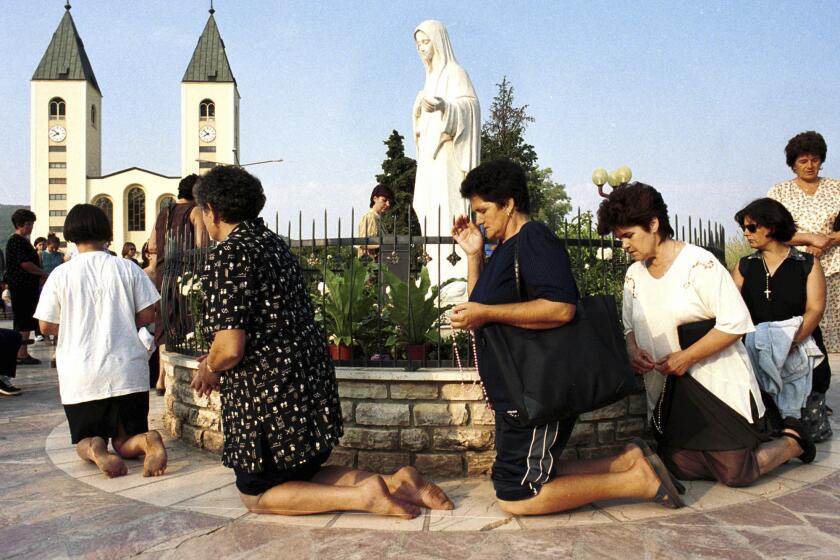THE MOSCOW SUMMIT : U.S. Teams Ready to Monitor Soviet INF Compliance
As the Senate voted to approve the new U.S.-Soviet intermediate-range missile treaty, special teams of American experts were completing their preparations Friday for the unprecedented task of making sure that all the Soviet weapons covered by the landmark pact are destroyed and that no new ones are produced.
“I’m about as optimistic as you can be when you’re embarking on something that’s never been done before,” said Army Brig. Gen. Roland Lajoie, director of the On-Site Inspection Agency that will oversee compliance with the treaty’s provisions. “We know the treaty, the environment and the resistances. I think we’re ready to go.”
Roughly a month from now, when inspections are to begin on both sides, more than 100 American technical experts and Soviet watchers, equipped with tape measures, flashlights, weight scales and cameras, will begin visiting 133 Soviet and East European missile bases, test sites and “elimination facilities.” They will watch as 1,752 Soviet short- and medium-range missiles are counted and then dismantled.
As the Soviets begin the same process, American teams of Russian-language specialists, counterintelligence officers and logistics experts will greet Soviet inspectors and show them through 26 storage, production and deployment sites in the United States and Western Europe, where 689 now-banned American missiles are or could be kept.
Monitoring for 3 Years
The monitoring of the destruction will continue for the next three years. Until the year 2001, each side will be permitted to conduct surprise inspections of the other’s missile sites and to post inspectors to watch the gates of one missile production facility.
The new superpower treaty is the first to allow on-site inspections by one nation on the other’s territory.
To prepare for the verification task, for which the on-site agency will spend $82.9 million this year alone, 300 government employees drawn from military and civilian agencies have been practicing new procedures for three months and preparing designated sites for the arrival of the Soviets, Lajoie said.
Among other things, they have rehearsed how they would react to a Soviet inspector who asks to defect. They have relaxed oppressively tight security procedures at sensitive installations to be visited. They have also begun rounding up everything from cold-weather gear to peanut butter and toilet paper for the U.S. inspectors who will be going to Votkinsk, the Soviet missile assembly plant at which the United States will maintain its 13-year watch post.
‘Excited’ About Access
“These people are all truly excited about the access they’ll have to the facilities of the Strategic Rocket Forces,” the Soviet military’s missile unit, Lajoie said. “These are the holiest of the holies in the Soviet Union. Few Soviets have ever visited these sites. And all of a sudden, here come these American inspectors with their tape measures and their scales. There are going to be a lot of adjustments made, certainly on the Soviet side.”
But Lajoie added that for many of the American inspectors, especially those who will stay in Votkinsk, 600 miles east of Moscow, the posting will involve real physical hardship. In the summer, the temperature there reaches 100 degrees. In the winter, it drops to 30 below zero.
The treaty allows the U.S. inspectors there to stray no farther than 30 miles from the plant and only with a Soviet escort. For Americans accustomed to movie theaters and restaurants, that probably will mean a menu of recreational activities limited to ice fishing and hunting for berries and mushrooms, said Lajoie.
“The Soviets have been unusually frank about what is available and have warned us that what’s there--not much of a market and virtually no fresh meat--is very modest,” Lajoie said.
Danger of Accidents
In addition, the teams face some danger, as they move through and live on the perimeters of installations that can be prone to accidents. In the past five months, there have been two explosions at U.S. facilities where solid-rocket engines and propellants are produced. An explosion rocked a Soviet facility in Pavlograd last week.
The Soviet teams may face other kinds of hazards, such as the rattlesnakes in Magna, Utah, where they will be watching Hercules Plant One until 2001, and scorpions in Arizona, where a destruction site for ground-launched cruise missiles will be located.
As head of the U.S. on-site teams, Lajoie brings extensive experience in Soviet watching to the challenge.
Fluent in Russian, he has served as chief of the U.S. Military Liaison Mission in Potsdam, East Germany, where a small team of U.S. intelligence officers are allowed to survey the East’s military moves. In March, 1985, a member of that team, Maj. Arthur D. Nicholson Jr., was shot to death in an encounter with a Soviet soldier--an incident that inflamed U.S.-Soviet tensions.
‘Correct and Friendly’
Lajoie said that with the extensive planning invested in the verification effort, no similar incidents are likely. In early run-throughs of the new procedures, he said, the security arrangements at U.S. installations have proven to be the biggest problem.
“There were too many people in the security role, too close,” he complained. “It conveyed the wrong impression. We’ll take commonplace security steps to protect what’s not in the treaty. But we also want to make sure we are polite and correct and friendly.”
Some Senate conservatives have criticized the treaty’s verification provisions, complaining that any further arms control efforts will require far more stringent monitoring procedures. But Lajoie called the efforts of the On-Site Inspection Agency a useful training ground for a future accord.
“We’ll go to school on (the medium-range missile treaty),” he said, “and hopefully our experiences will go into the strategic arms reduction negotiations, either to validate the on-site inspection process or suggest alternatives.”
More to Read
Start your day right
Sign up for Essential California for news, features and recommendations from the L.A. Times and beyond in your inbox six days a week.
You may occasionally receive promotional content from the Los Angeles Times.







